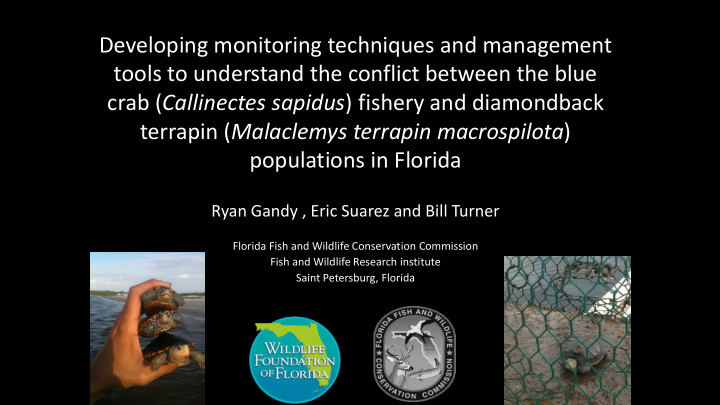



Developing monitoring techniques and management tools to understand the conflict between the blue crab ( Callinectes sapidus ) fishery and diamondback terrapin ( Malaclemys terrapin macrospilota ) populations in Florida Ryan Gandy , Eric Suarez and Bill Turner Florida Fish and Wildlife Conservation Commission Fish and Wildlife Research institute Saint Petersburg, Florida
Investigation into the interaction between terrapins and blue crab traps in Florida 2011 • Investigated the interaction between blue crab traps and a known terrapin colony on Lanark Reef. • Developed search methodologies, standardized to habitat, for terrapin population assessments. • Developed terrapin ‘hot spot’ maps for management and targeted research.
Investigate the interaction between blue crab traps and a known terrapin colony on Lanark Reef
Terrapin/Crab Trap Interactions Introducing the TUBA trap
Methodology Fall Trapping Study
Fall Results 0 terrapins in 930 trap days 187 terrapins captured by hand on the island during this time
Methodology Spring Trapping Study Submerged Traps
Methodology Spring Trapping Study Intertidal traps Placed in vegetation
Results Submerged traps 2 terrapins in 1995 trap days First female (104 mm CL) 44 m from shore in 1.83 m water depth Second female (120 mm CL) 136 m from shore in 1.71 m water depth Intertidal traps 65 terrapins in 330 trap days
Discussion Submerged Traps It is rare for Terrapins at Lanark Reef to enter crab traps, which was unexpected. Habitat type, trap type, crab trapping history may be a factor. Intertidal Traps Catch of terrapins in traps set in the vegetated intertidal zone was high. This is not a zone where crab traps are placed for fishing. Ghost pots that wash up onto intertidal areas can potentially be harmful to terrapin populations.
Developed search methodologies, standardized to habitat, for terrapin population assessments Search Methods Tide Levels Low Medium High Weather Patterns Clear Partly Cloudy Cloudy Habitat Types Open sand Water near shore Vegetation Vegetation with tidal wrack
Results Tide Total Captures Man Minutes CPUE Low 273 1020 0.27 (1 terrapin every 3.7 minutes) Medium 107 540 0.20 (1 terrapin every 5.0 minutes) High 126 900 0.14 (1 terrapin every 7.1 minutes) Kruskal-Wallis Test – H=5.94, DF=2, p = 0.05 A B B
Results Weather Total Captures Man Minutes CPUE Clear 215 900 0.24 (1 terrapin every 4.2 minutes) Partly Cloudy 191 600 0.33 (1 terrapin every 3.1 minutes) Cloudy 100 760 0.13 (1 terrapin every 7.6 minutes) Kruskal-Wallis Test – H=18.62, DF=2, p<0.001 A A B
Results Habitat Total Captures Open Sand 0 Open water near shore 1 Vegetation 147 Vegetation with tidal wrack 353 Chi-square test: X 2 = 84.87, p < 0.001
Discussion Best time to search for terrapin’s is during low tide on clear or partly cloudy days. Terrapins used habitat associated with some form of vegetative structure Primary prey plentiful within vegetation Escape from heat Escape from predators Very difficult to compare technique to other studies. Different sampling and trapping techniques
Lanark Terrapin population assessment Methods Individually marked and PIT tagged each terrapin Upon capture we gathered various morphometric measurements
Lanark Terrapin population assessment We captured a total of 442 new individuals (800 total captures) in 8 months of sampling. Population structure – 5.3 % juveniles (includes yearlings), 53.4 % males, and 41.3 % females. Population estimate for Lanark Reef = 1,124 ± 127 terrapins A closed model that assumed different mark-recapture probabilities.
Terrapin ‘hot spot’ maps for management and targeted research
Marine Fisheries Trip Ticket Fishing Area Code
Databases for Terrapin Populations Source Terrapin # % of Total Big Bend Survey 63 4.5% Herpetological Atlas 1928-2012 186 13.3% Lanark Reef Study 2011 507 36.3% FWRI FIM Monitoring 2000-2012 641 45.9%
These maps, data and metadata are available to the public for review and download: http://atoll.floridamarine.org/Quickmaps/KMZ_download.htm
Recommend
More recommend